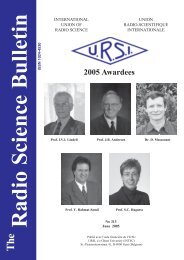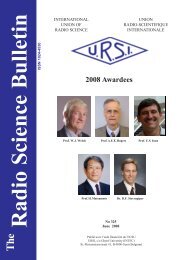Multi-physics Simulation for Radio Frequency Ion Trap ... - URSI
Multi-physics Simulation for Radio Frequency Ion Trap ... - URSI
Multi-physics Simulation for Radio Frequency Ion Trap ... - URSI
You also want an ePaper? Increase the reach of your titles
YUMPU automatically turns print PDFs into web optimized ePapers that Google loves.
Pr = e P αe<br />
2ε<br />
0<br />
KT μ<br />
(1)<br />
where, Pr is the probability of collision, m is the reduced mass of the ion, P is the pressure of the buffer gas, e is the ion<br />
charge, T is the temperature of the system, α e is the electron polarization of the buffer gas and ε 0 is the permittivity of<br />
air. The energy transfer between the ion and neutral particle is modeled by the hard sphere collision model, where we<br />
assume the collision is elastic and no internal energy is obtained inside ion or neutral molecule from the collision.<br />
The space charge effect which expands the ion cloud distribution is characterized by calculating the Coulomb<br />
<strong>for</strong>ce between every pair of charged particles. So as the ion number increases the total calculation time <strong>for</strong> this space<br />
charge effect will increase rapidly. The trajectory of ion motion is numerically obtained by solving the Newton’s<br />
Equation using 4-th order Runge Kutta integration. To minimize the numerical accumulative error during ion trajectory<br />
integration, the integration time step 1 ns is chosen. The electric field the ion feels from the trap is obtained by looking<br />
up the field solution exported from HFSS, and linear interpolation is made between grid points. The collision<br />
probability is calculated at the very beginning of the simulation. A random number is generated at every time step <strong>for</strong><br />
every ion and if this number is bigger than a threshold determined by the collision probability, a collision happens. The<br />
velocity changes of the ion because of this collision is calculated and set as the new velocity of this ion.<br />
3. Electric field convergence study<br />
Fig. 1 (a) demonstrates a typical ion trap <strong>for</strong> miniaturized mass spectrometers. This device, named a rectilinear<br />
ion trap, utilizes a quadrupolar pseudo potential well combined with a small percent of high order fields created by the<br />
application of RF voltage on a pair of electrodes to store or mass selectively ejects ions. In practice, the quality of the<br />
RF voltage signal is very important to provide a highly accurate spectrum. In simulation, this translates into the need <strong>for</strong><br />
highly accurate electric field simulations to accurately predict the per<strong>for</strong>mance of the designed ion trap. Also, the<br />
necessary field simulation quality in the electrical domain is determined by the ion trap per<strong>for</strong>mance in the chemical<br />
sensing domain, which makes this a cross domain problem and can not be solved by traditional convergence criteria (S<br />
parameter or delta energy, <strong>for</strong> instance).<br />
Fig. 1. Geometries of <strong>Ion</strong> <strong>Trap</strong>s. (a) Standard RIT instrumentation with dimensions 10×8×43.2 mm in X, Y and Z directions respectively,<br />
which is used in our 3-D simulation and experiment, (b) 2-D Rectilinear <strong>Ion</strong> <strong>Trap</strong> (RIT) model which is used as the simulation model in<br />
HFSS. Two PML are put at the front and back to cut the trap and mimic the infinite long RIT.<br />
With the challenge of highly accurate field simulation needs and the nature of an RIT field distribution as<br />
discussed in section II, we begin by considering an infinitely long rectilinear ion trap consisting of 4 plate electrodes<br />
separated by small isolation gaps, as shown in Fig. 1 (b). The use of the infinitely long rectilinear ion trap model allows<br />
the truncation of the simulation space without losing the functional RIT cross section field distribution. The infinite<br />
length is imitated by Perfect Magnetic Walls (PML) at the front and back cross sections. The truncated simulation space<br />
allows <strong>for</strong> dense mesh operations to test convergence criteria by allowing oversampling of the region and accurate<br />
determination of the level of convergence needed. The lessons learned from the cross sectional simulations will be<br />
applied to a full 3-D simulation and design process in later section.<br />
In Fig. 1 (b), the rectilinear ion trap dimensions were: a = 10 mm, b = 8 mm, the gap size g = 0.2 mm and w = 1<br />
mm. The sources were RF and DC voltages applied on the top and bottom plate electrodes. The electric field simulation<br />
was per<strong>for</strong>med several times with different mesh densities, from 8.6 to 2554 tetrahedra/mm 3 . This step by step<br />
progression of mesh densities allow us to determine how the mesh density will affect the field accuracy and furthermore
















